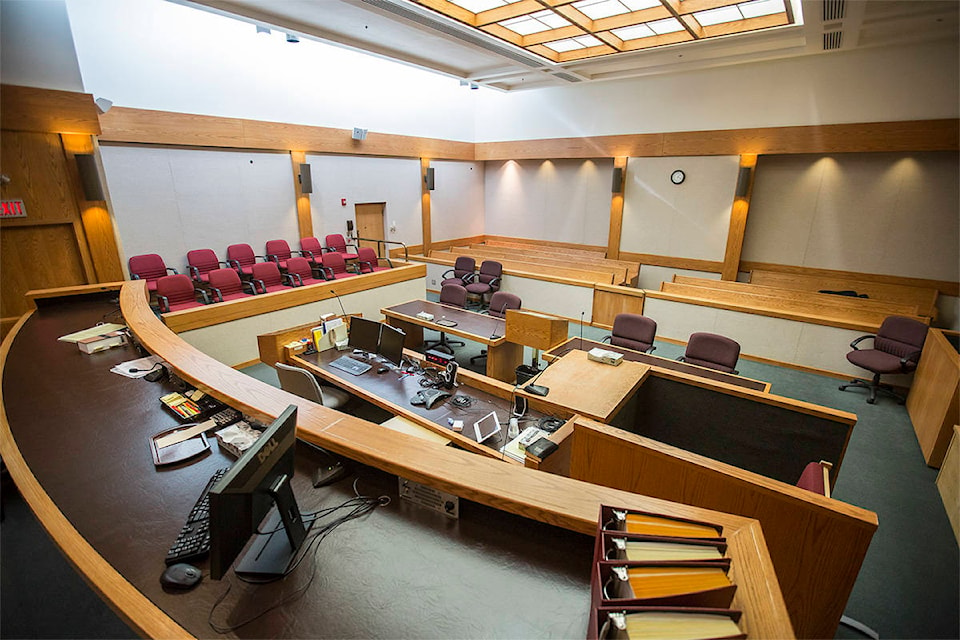A Whitehorse murder trial is nearing its end, with the jury set to determine the fate of the accused next week.
Edward James Penner, 22, stands charged with first-degree murder in the 2017 death of Adam Cormack, 25.
Cormack was killed by a single gunshot to the head, his body discovered on a dirt road near a gravel pit in Ibex Valley on June 28, 2017.
Crown attorney Tom Lemon told the 14-person jury the afternoon of Sept. 12 that the Crown was resting its case, a little more than two weeks after it called the first of its 18 witnesses to the stand.
Andre Ouellette, one of two lawyers representing Penner, followed that by saying the defence would not be calling any evidence.
The trial had been initially estimated to take about four weeks, with the courtroom booked up to Sept. 27.
The last witness to take the stand was Whitehorse RCMP Const. John Gillis, an officer with force’s Major Crime Unit who was the lead investigator on the case.
Gillis testified that he first became aware of Penner after a colleague told him about a man she’d arrested under the Mental Health Act on June 30, 2017. The officer didn’t recognize the man and neither did anyone else at the arrest processing unit, Gillis said, which was unusual; the man only gave his name as “Tanner.”
Police were preparing to arrest Tanner for allegedly pointing a firearm and uttering threats, and Gillis said he went up to the arrest processing unit on July 1, 2017, to speak with him.
Gillis said Tanner told him his real name was Edward James Penner, an identity that was confirmed after Gillis ran “Tanner’s” fingerprints through a national database and they matched with prints previously taken from Penner.
At the same time, Gillis testified, investigators were gathering more information related to Cormack’s death and accumulated enough information that, later the same day, Penner was arrested again, this time for murder.
Gillis also confirmed that there had also initially been two other locations of interest following the discovery of Cormack’s body — the Kulan gravel pit, where a burnt-out vehicle was found, and the Cousins airstrip, where a number of burnt items were found.
Investigators collected evidence from both scenes, Gillis said, but didn’t find anything to suggest that either the pit or airstrip were linked to Cormack, or to each other.
One point of contention in Gillis’s testimony was why Penner was never tested for gunshot residue.
Gillis told the Crown that when arrested, Penner was not wearing the same clothes he was seen wearing in security camera footage the night of June 27, 2017. As well, Gillis testified that gunshot residue only lasts a few hours on the skin, adding that the RCMP’s lab would not accept swabs taken more than 12 hours after a shooting.
As Penner was arrested days after Cormack was shot, Gillis said he believed that testing him for gunshot residue wouldn’t have produced anything that would have assisted the investigation.
Defence lawyer Andre Ouellette, however, challenged Gillis’s statement on the perishability of gunshot residue, suggesting that some literature indicates that it can persist on the skin for up to 150 hours.
Gillis said all the literature he read had provided a much shorter span of about six hours.
Gillis also confirmed that Penner’s name had began circulating in the media by July 2, when Penner made his first court appearance.
The jury also heard from two other witnesses before the Crown rested its case — Yukon RCMP Const. Neil Gillis, an expert on drug culture (and cousin of John Gillis) earlier in the day on Sept. 12, and RCMP firearm and ammunition expert Megan Evoy the day before.
Evoy, a civilian who works at the RCMP’s forensics lab in Surrey, B.C., had not directly worked on the case; her colleague, Christopher Kerr, had examined and produced a report on a bullet and spent cartridge casing collected from the scene.
Kerr, however, died before the trial.
Evoy confirmed that she had reviewed Kerr’s work notes and report. She said she agreed with his findings that the cartridge casing was consistent with a 5.56 x 45 mm NATO calibre, while the bullet, which had green paint flecks on the nose, was part of the .22 calibre family.
The 5.56 x 45 mm NATO is a steel-tipped “penetrator” round, she explained, specifically designed to pass through a target. While originally intended for military use, she said, they’re commonly available.
While the cartridge casing and bullet would have been compatible with each other, Evoy said there was no way to confirm that the two specific exhibits were, at any point, the same cartridge.
The Crown also showed Evoy photos of Penner holding a gun. She said the firearm appeared to be an AR-15, which she described under cross-examination as a commonly-made and available style of gun.
The testimony of Neil Gillis, meanwhile, largely focused on slang used in Facebook messages sent from a Facebook account belonging to “James Tanner,” in which Tanner appears to be talking about selling crack cocaine in Whitehorse.
Among other things, Gillis explained, based on his experience speaking to addicts and participating in drug investigations, “coke” is a reference to cocaine; “rock” means crack cocaine; and “crazy, crazy paper” means making a lot of money.
The jury is expected to hearing closing arguments and begin deliberations next week.
Contact Jackie Hong at jackie.hong@yukon-news.com
